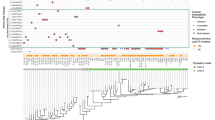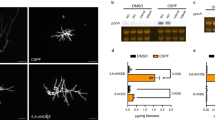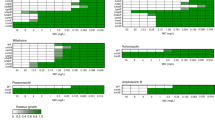Abstract
Fungal transcription factor Upc2 senses ergosterol levels and regulates sterol biosynthesis and uptake. Constitutive activation of Upc2 causes azole resistance in Candida species. We determined the structure of ergosterol-bound Upc2, revealing the ligand specificity and transcriptional regulation. Ergosterol binding involves conformational changes of the ligand-binding domain, creating a shape-complementary hydrophobic pocket. The conserved helix α12 and glycine-rich loop are critical for sterol recognition by forming the pocket wall. The mutations of the glycine-rich loop inhibit ligand binding by steric clashes and constitutively activate Upc2. The translocation of Upc2 is regulated by Hsp90 chaperone in a sterol-dependent manner. Ergosterol-bound Upc2 associates with Hsp90 using the C-terminal tail, which retains the inactive Upc2 in the cytosol. Ergosterol dissociation induces a conformational change of the C-terminal tail, releasing Upc2 from Hsp90 for nuclear transport by importin α. The understanding of the regulatory mechanism provides an antifungal target for the treatment of azole-resistant Candida infections.

This is a preview of subscription content, access via your institution
Access options
Access Nature and 54 other Nature Portfolio journals
Get Nature+, our best-value online-access subscription
$29.99 / 30 days
cancel any time
Subscribe to this journal
Receive 12 print issues and online access
$259.00 per year
only $21.58 per issue
Buy this article
- Purchase on Springer Link
- Instant access to full article PDF
Prices may be subject to local taxes which are calculated during checkout






Similar content being viewed by others
Data availability
Coordinates and structure factors for the reported crystal structures have been deposited in the PDB with the accession codes 7VPR (CgUpc2-ergosterol), 7VPU (LtUpc2-ergosterol), 7XB5 (ScUpc2-T4L), 7VPS (apo CgImpα), and 7VPT (CgImpα-Upc2 NLS). All structures cited in this publication are available under their respective PDB accession codes. Other data supporting the findings of this work are provided within the manuscript and its related source data. Source data are provided with this paper.
References
Maguire, S. L. et al. Zinc finger transcription factors displaced SREBP proteins as the major Sterol regulators during Saccharomycotina evolution. PLoS Genet. 10, e1004076 (2014).
Perfect, J. R. The antifungal pipeline: a reality check. Nat. Rev. Drug Disco. 16, 603–616 (2017).
Whaley, S. G. et al. Azole antifungal resistance in Candida albicans and emerging non-albicans Candida species. Front Microbiol 7, 2173 (2016).
Anderson, J. B. Evolution of antifungal-drug resistance: mechanisms and pathogen fitness. Nat. Rev. Microbiol. 3, 547–556 (2005).
Cowen, L. E., Sanglard, D., Howard, S. J., Rogers, P. D. & Perlin, D. S. Mechanisms of antifungal drug resistance. Cold Spring Harb. Perspect. Med 5, a019752 (2014).
Rogers, P. D. & Barker, K. S. Genome-wide expression profile analysis reveals coordinately regulated genes associated with stepwise acquisition of azole resistance in Candida albicans clinical isolates. Antimicrob. Agents Chemother. 47, 1220–1227 (2003).
MacPherson, S. et al. Candida albicans zinc cluster protein Upc2p confers resistance to antifungal drugs and is an activator of ergosterol biosynthetic genes. Antimicrob. Agents Chemother. 49, 1745–1752 (2005).
Vik, A. & Rine, J. Upc2p and Ecm22p, dual regulators of sterol biosynthesis in Saccharomyces cerevisiae. Mol. Cell. Biol. 21, 6395–6405 (2001).
Davies, B. S., Wang, H. S. & Rine, J. Dual activators of the sterol biosynthetic pathway of Saccharomyces cerevisiae: similar activation/regulatory domains but different response mechanisms. Mol. Cell. Biol. 25, 7375–7385 (2005).
Whaley, S. G. et al. UPC2A is required for high-level azole antifungal resistance in Candida glabrata. Antimicrob. Agents Chemother. 58, 4543–4554 (2014).
Yang, H. et al. Structural mechanism of ergosterol regulation by fungal sterol transcription factor Upc2. Nat. Commun. 6, 6129 (2015).
Moye-Rowley, W. S. Linkage between genes involved in azole resistance and ergosterol biosynthesis. PLoS Pathog. 16, e1008819 (2020).
Jorda, T. & Puig, S. Regulation of ergosterol biosynthesis in Saccharomyces cerevisiae. Genes 11, 795 (2020).
Vasicek, E. M., Berkow, E. L., Flowers, S. A., Barker, K. S. & Rogers, P. D. UPC2 is universally essential for azole antifungal resistance in Candida albicans. Eukaryot. Cell 13, 933–946 (2014).
Dunkel, N. et al. A gain-of-function mutation in the transcription factor Upc2p causes upregulation of ergosterol biosynthesis genes and increased fluconazole resistance in a clinical Candida albicans isolate. Eukaryot. Cell 7, 1180–1190 (2008).
Heilmann, C. J., Schneider, S., Barker, K. S., Rogers, P. D. & Morschhauser, J. An A643T mutation in the transcription factor Upc2p causes constitutive ERG11 upregulation and increased fluconazole resistance in Candida albicans. Antimicrob. Agents Chemother. 54, 353–359 (2010).
Hoot, S. J., Smith, A. R., Brown, R. P. & White, T. C. An A643V amino acid substitution in Upc2p contributes to azole resistance in well-characterized clinical isolates of Candida albicans. Antimicrob. Agents Chemother. 55, 940–942 (2011).
Flowers, S. A. et al. Gain-of-function mutations in UPC2 are a frequent cause of ERG11 upregulation in azole-resistant clinical isolates of Candida albicans. Eukaryot. Cell 11, 1289–1299 (2012).
Backe, S. J., Sager, R. A., Woodford, M. R., Makedon, A. M. & Mollapour, M. Post-translational modifications of Hsp90 and translating the chaperone code. J. Biol. Chem. 295, 11099–11117 (2020).
Leach, M. D., Klipp, E., Cowen, L. E. & Brown, A. J. Fungal Hsp90: a biological transistor that tunes cellular outputs to thermal inputs. Nat. Rev. Microbiol. 10, 693–704 (2012).
Pearl, L. H. & Prodromou, C. Structure and mechanism of the Hsp90 molecular chaperone machinery. Annu. Rev. Biochem. 75, 271–294 (2006).
Murphy, P. J. Regulation of glucocorticoid receptor steroid binding and trafficking by the hsp90/hsp70-based chaperone machinery: implications for clinical intervention. Leukemia 19, 710–712 (2005).
Diezmann, S., Michaut, M., Shapiro, R. S., Bader, G. D. & Cowen, L. E. Mapping the Hsp90 genetic interaction network in Candida albicans reveals environmental contingency and rewired circuitry. PLoS Genet. 8, e1002562 (2012).
Van Hauwenhuyse, F., Fiori, A. & Van Dijck, P. Ascorbic acid inhibition of Candida albicans Hsp90-mediated morphogenesis occurs via the transcriptional regulator Upc2. Eukaryot. Cell 13, 1278–1289 (2014).
Le Fur, Y., Maume, G., Feuillat, M. & Maume, B. F. Characterization by gas chromatography/mass spectrometry of sterols in Saccharomyces cerevisiae during autolysis. J. Agric. Food Chem. 47, 2860–2864 (1999).
Fontes, M. R., Teh, T., Jans, D., Brinkworth, R. I. & Kobe, B. Structural basis for the specificity of bipartite nuclear localization sequence binding by importin-α. J. Biol. Chem. 278, 27981–27987 (2003).
Lorenz, O. R. et al. Modulation of the Hsp90 chaperone cycle by a stringent client protein. Mol. Cell 53, 941–953 (2014).
Noddings, C. M., Wang, R. Y., Johnson, J. L. & Agard, D. A. Structure of Hsp90–p23–GR reveals the Hsp90 client-remodelling mechanism. Nature 601, 465–469 (2022).
Wang, R. Y. et al. Structure of Hsp90–Hsp70–Hop–GR reveals the Hsp90 client-loading mechanism. Nature 601, 460–464 (2022).
Borkovich, K. A., Farrelly, F. W., Finkelstein, D. B., Taulien, J. & Lindquist, S. hsp82 is an essential protein that is required in higher concentrations for growth of cells at higher temperatures. Mol. Cell. Biol. 9, 3919–3930 (1989).
Nicola, A. M. et al. The stress responsive and morphologically regulated hsp90 gene from Paracoccidioides brasiliensis is essential to cell viability. BMC Microbiol. 8, 158 (2008).
Naar, A. M. & Thakur, J. K. Nuclear receptor-like transcription factors in fungi. Genes Dev. 23, 419–432 (2009).
Luo, J., Jiang, L. Y., Yang, H. & Song, B. L. Intracellular cholesterol transport by sterol transfer proteins at membrane contact sites. Trends Biochem. Sci. 44, 273–292 (2019).
Pratt, W. B. & Toft, D. O. Regulation of signaling protein function and trafficking by the hsp90/hsp70-based chaperone machinery. Exp. Biol. Med. 228, 111–133 (2003).
Lee, H. C., Hon, T. & Zhang, L. The molecular chaperone Hsp90 mediates heme activation of the yeast transcriptional activator Hap1. J. Biol. Chem. 277, 7430–7437 (2002).
Sheffield, P., Garrard, S. & Derewenda, Z. Overcoming expression and purification problems of RhoGDI using a family of ‘parallel’ expression vectors. Protein Expr. Purif. 15, 34–39 (1999).
Liebschner, D. et al. Macromolecular structure determination using X-rays, neutrons and electrons: recent developments in Phenix. Acta Crystallogr D Struct. Biol. 75, 861–877 (2019).
Acknowledgements
This research was supported by a grant from National Research Foundation of Korea (NRF) by the Ministry of Education, Science and Technology (grant no. 2019R1A2C1085530 to Y.J.I.) and by a grant from the Korea Health Technology R&D Project through the Korea Health Industry Development Institute (KHIDI), funded by the Ministry of Health & Welfare, Republic of Korea (grant no. HI20C0079 to Y.J.I.).
Author information
Authors and Affiliations
Contributions
Y.J.I. and L.T. designed the project. L.T., B.J., L.C, and H.Y. cloned the genes, purified and crystallized recombinant proteins. L.T. and L.C. performed the ligand-binding assays and yeast cell biology experiments. H.Y., L.T., and Y.J.I. collected and analyzed the X-ray data. G.K. analyzed the biochemical data. Y.J.I. wrote the manuscript. All authors discussed the results and approved the manuscript.
Corresponding author
Ethics declarations
Competing interests
The authors declare no competing interests.
Peer review
Peer review information
Nature Chemical Biology thanks Anders Näär, David Rogers and the other, anonymous, reviewer(s) for their contribution to the peer review of this work.
Additional information
Publisher’s note Springer Nature remains neutral with regard to jurisdictional claims in published maps and institutional affiliations.
Extended data
Extended Data Fig. 1 Sequence alignments of Upc2 homologs.
a, The sequence alignments of the N-terminal regions of Upc2 homologs from C. glabrata and S. cerevisiae. The six cysteines coordinating Zinc clusters were colored in red. The variable residues in the DBDs of CgUpc2 homologs were indicated by green arrows. The corresponding residues in ScUpc2 and ScEcm22 are well conserved and colored in blue. b, The sequence alignments of Upc2 LBDs. The secondary structure elements were based on the structure of CgUpc2. The helix α12 and the C-terminal tail are shown in red. The disordered region in the crystal structure is indicated with dotted lines and boxes. The residues composing the hydrophobic sterol-binding pocket are marked with filled circles. The residues contacting the hydrocarbon rings of sterols are shown in orange circles, and the residues contacting the hydrocarbon side chain in blue circles, respectively. The constitutive active mutations of Upc2 identified in the clinical isolates of azole-resistant C. albicans18 were indicated by red arrows. The insertion mutation of the thrombin recognition sequence was indicated by purple letters.
Extended Data Fig. 2 The 2Fo-Fc electron density maps of the crystal structures.
The final models were superimposed into the electron densities.
Extended Data Fig. 3 B-factor representation of the Cg and LtUpc2 LBDs.
The disordered regions which were not included in the structural models were indicated by dotted lines.
Extended Data Fig. 4 Sterol-binding assay of ScUpc2 and CgUpc2 constructs.
a-c, The DHE binding assays of ScUpc2 LBD mutants. d-g, Ergosterol-competition assay of CgUpc2 constructs. The competing ergosterol was added to the Upc2 LBD preloaded with DHE. The spectral measurements were repeated two times, and the representative data were shown.
Extended Data Fig. 5 Structure of CgImpα-Upc2 NLS complex.
a, Association of the C-terminal NLS sequence from a neighboring molecule to the importin α in a head-to-tail fashion in the crystal lattice. b, Structural comparison of apo importin α and the NLS-bound importin α. The Upc2 NLS sequence (residues 24-47) fused to the C-terminus of importin α is colored in red. c, Surface representation of the CgImpα–Upc2 NLS complex. The electrostatic surface was shown for CgImpα ARM. d, Overall structure of the CgImpα–Upc2 NLS complex. The ARM domain of CgImpα is colored in blue to red from the N- to C- terminus. The Upc2 NLS is shown in stick models.
Extended Data Fig. 6 The Upc2 NLS bind site of CgImpα.
a, Detailed view of the CgImpα–Upc2 NLS binding interface. The Upc2 NLS is shown in orange and the importin α residues in green. Hydrogen bonds and salt bridges are shown in dotted lines. b, The schematic representation of the CgImpα–Upc2 NLS interaction. The non-covalent interactions between Impα and Upc2 NLS were summarized in a schematic representation. c, Structural comparison of the NLS-binding modes of the various Impα–cargo complexes. The bound NLS sequences were shown for Upc2 (this study), SRM1 (PDB: 4OIH), Nucleoplasmin (PDB: 1EE5), RB1 (PDB: 1PJM), and CBP90 (PDB: 3UKY). d, ITC analysis of the importin α and Upc2 NLS interaction. The CgImpα in the cell was titrated with the Upc2 NLS peptide or MBP-Upc2 NLS in the syringe. The ITC measurements were repeated two times, and one representative data was shown for each construct.
Extended Data Fig. 7 Conservation of a client binding mode of Hsp90 on CgUpc2 and GR.
a, The sequence alignments of the CT regions of Upc2 homologs with the Hsp90-binding region of human GR. The conserved Hsp90-binding residues in the client proteins were indicated by blue shades. Asterisks indicate the GR residues interacting with HsHsp90 in the maturation complex28, and purple triangles indicate the residues interacting with HsHsp90 in the loading complex29. b, Structure of HsHsp90–GR maturation complex. The sterol-bound GR is shown in black ribbons. The N-terminal extended loop binds to the lumen of the HsHsp90 homodimer. c, The GR-binding site of Hsp90. The red labels indicate the mutated residues at the equivalent positions in CgHsp90.
Extended Data Fig. 8 ITC analysis of Hsp90 - Upc2 interaction.
a, ITC analysis of L594T and M589E mutants of CgHsp90 for CgUpc2 binding. b, The two Hsp90 isoforms (Hsc82 and Hsp82) of S. cerevisiae were tested for the ergosterol-dependent interaction of the ScUpc2 LBD by ITC. M589E mutation in ScHsc82 abolished the interaction with the ScUpc2 LBD-ergosterol. The ITC measurement was repeated two times, and one representative data was shown for each construct (Supplementary Fig. 4). c, Structural model of the CgHsp90 – CgUpc2 complex. The human Hsp90 dimer in the maturation complex was used for the template of CgHsp90. The extended loop residues of GR interacting with Hsp90 were replaced by the CT sequence of CgUpc2. The dimeric structure of CgUpc2 LBD was manually located to the N-terminus of the modeled CT in an orientation with minimum steric clashes between Hsp90 and Upc2.
Extended Data Fig. 9 Hsp90-dependent localization of Upc2.
a-e, To test the significance of ScHsp90 isoforms (Hsc82 and Hsp82) on Upc2 regulation, the localization of GFP-Upc2 constructs was examined in the yeast knockout strains (hsc82Δ or hsp82Δ) grown in the presence of ergosterol. The microscopic imaging of the yeast cells was repeated two times with consistent results. More than 300 cells were examined, and the cell images representing higher than 80% of the cell population were shown in the panels. Scale bar, 3 µm.
Extended Data Fig. 10 Transcriptional control of ergosterol level and azole resistance.
a, Transcriptional activity of Upc2. ERG2-lacZ reporters were used to determine the contribution of each Upc2 construct to the regulation of ERG2 promotor. The assay values represent the average of three independent experiments. All error bars indicate standard deviations. The individual data points for three-repeating experiments were overlaid in dots for each bar graph. b, Quantification of total ergosterol in yeast cells. Yeast upc2Δ ecm22Δ strain transformed with the YCplac33 plasmids containing full cassette of various UPC2 alleles were analyzed for their cellular ergosterol levels. Each data point is the average of three measurements. The error bars indicate standard deviations. The individual data points for three-repeating experiments were overlaid in dots for each bar graph. c, Susceptibilities to fluconazole of the upc2Δ ecm22Δ yeast strain expressing wild-type or mutant UPC2 alleles. The strains were initially grown without fluconazole, and the dilution series of 1/3, 1/9, 1/27, 1/81 were spotted on the agar plates containing fluconazole and incubated for 36 h.
Supplementary information
Supplementary Information
Supplementary Table 1 and Supplementary Figs 1–4.
Source data
Source Data Fig. 4
Unprocessed SDS-PAGE gel images with three repeats.
Source Data Fig. 6
The zip file contains two image files in tif and jpg files. Source_Data_Fig_6a.tif contains unprocessed western blots images for Fig. 6a. Source_Data_Fig_6b-i.jpg contains uncropped yeast cell images for Fig. 6b–i.
Source Data Extended Data Fig. 9
It contains uncropped yeast cell images for Fig. 9a–e.
Source Data Extended Data Fig. 10
Statistical source data for the bar graphs of Fig. 10a,b.
Rights and permissions
Springer Nature or its licensor holds exclusive rights to this article under a publishing agreement with the author(s) or other rightsholder(s); author self-archiving of the accepted manuscript version of this article is solely governed by the terms of such publishing agreement and applicable law.
About this article
Cite this article
Tan, L., Chen, L., Yang, H. et al. Structural basis for activation of fungal sterol receptor Upc2 and azole resistance. Nat Chem Biol 18, 1253–1262 (2022). https://doi.org/10.1038/s41589-022-01117-0
Received:
Accepted:
Published:
Issue Date:
DOI: https://doi.org/10.1038/s41589-022-01117-0
This article is cited by
-
Molecular mechanisms governing antifungal drug resistance
npj Antimicrobials and Resistance (2023)



